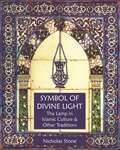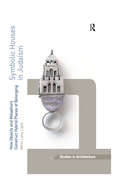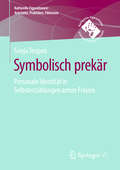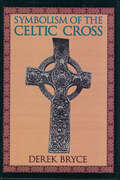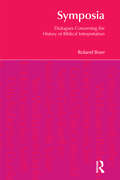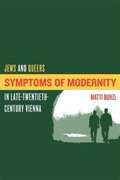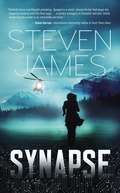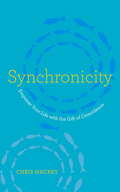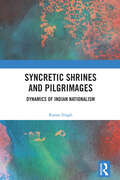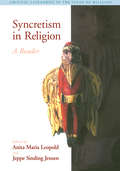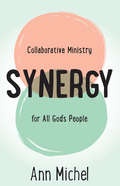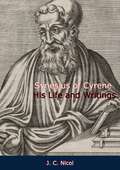- Table View
- List View
Symbol and Sacrament: A Sacramental Reinterpretation of Christian Existence
by Louis-Marie ChauvetChauvet charts a reorientation in sacramental theology from the scholastic treatments. In this approach the subject is as much "grasped" by the symbolic representation as is the object being interpreted.
Symbol of Divine Light: The Lamp in Islamic Culture and Other Traditions
by Nicholas StoneSymbol of Divine Light surveys the history of the mosque lamp, describing the numerous variants made in different historical periods and containing more than 200 stunning color and b/w illustrations. The deep significance of light and the lamp in Islamic culture and other traditions—Jewish, Christian, Zoroastrian, Hindu, and Buddhist—is also explored, with reference made to the writings of authors belonging to the &“Traditionalist school,&” notably Frithjof Schuon, René Guénon, Titus Burckhardt, and Martin Lings. The book presents a detailed exploration of the famous Koranic Verse of Light and the symbolism of its constituent elements: light, the niche, the lamp, glass, oil, and the tree. Parallels are also drawn with other traditions, indicating a universal symbolism.Symbol of Divine Light concludes that the most important function of the mosque lamp was as a symbolic reminder of the Verse of Light, as demonstrated by examples that were virtually non-functional as lighting devices and also the extensive use of the mosque lamp as a decorative motif in Islamic architecture. The book aims to give the reader an opportunity to contemplate the meaning of the mosque lamp as a symbol of Divine Light.
Symbolic Blackness and Ethnic Difference in Early Christian Literature: BLACKENED BY THEIR SINS: Early Christian Ethno-Political Rhetorics about Egyptians, Ethiopians, Blacks and Blackness
by Gay L ByronHow were early Christians influenced by contemporary assumptions about ethnic and colour differences?Why were early Christian writers so attracted to the subject of Blacks, Egyptians, and Ethiopians?Looking at the neglected issue of race brings valuable new perspectives to the study of the ancient world; now Gay Byron's exciting work is the first to survey and theorise Blacks, Egyptians and Ethiopians in Christian antiquity.By combining innovative theory and methodology with a detailed survey of early Christian writings, Byron shows how perceptions about ethnic and color differences influenced the discursive strategies of ancient Christian authors. She demonstrates convincingly that, in spite of the contention that Christianity was to extend to all peoples, certain groups of Christians were marginalized and rendered invisible and silent.Original and pioneering, this book will inspire discussion at every level, encouraging a broader and more sophisticated understanding of early Christianity for scholars and students alike.
Symbolic Houses in Judaism: How Objects and Metaphors Construct Hybrid Places of Belonging (Ashgate Studies in Architecture)
by Mimi Levy LipisInvestigating Jewish spatial practices by exploring the symbol of the house in Judaism, this book examines two groups of houses: ritual objects based on the iconology of the house (ritual houses) and house metaphors (the text, community and the covenant with god as house). This unique pairing is explored as place-making tools which exist in a constant state of tension between diaspora and belonging. Containing many photographs of historical and contemporary artefacts from Europe, Israel and the United States, this book maps out the intersection of architecture, Jewish studies, cultural and gender studies and opens up the discussion of distinctly Jewish objects and metaphors to discourses taking place outside explicitly Jewish contexts.
Symbolisch prekär: Personale Identität in Selbsterzählungen armer Frauen (Kulturelle Figurationen: Artefakte, Praktiken, Fiktionen)
by Sonja TeupenIm Zentrum der mikrosoziologisch und kulturpsychologisch informierten Studie steht die Subjektposition der armen Frau. Im Unterschied zu anderen Subjektpositionen geht diese nicht mit einem Versprechen sozialer Anerkennung einher, sondern erfolgt vorrangig unter Bedingungen symbolischer Prekarität. Anhand von Selbsterzählungen von Frauen in Armutslagen in Deutschland und den USA wird untersucht, wie die Erzählerinnen ihr Subjektsein narrativ verhandeln und damit personale Identität konstituieren. Die Analyse im methodologischen Rahmen der relationalen Hermeneutik rekonstruiert zwei Ebenen des Gegenstandes: Thematisch plausibilisieren die Erzählerinnen ihr Armsein entlang der Topoi Krankheit, Trennung, Kindheit und Schicksal. Strukturell sind ihre Erzählungen aufgespannt zwischen den Punkten Widerfahrnis und Handlung, Identifikation und Differenz, Zurechnung und Autonomie.Der InhaltEinführungSozial- und kulturwissenschaftliche Identitätsforschung im interpretativen ParadigmaPersonale IdentitätMethodik der Analyse personaler IdentitätFallvergleich und Typisierung: AnalyseTopik und Typologie: DiskussionSchlussDie AutorinDr. Sonja Teupen ist Wissenschaftliche Mitarbeiterin für Qualitative Methoden am Deutschen Zentrum für Neurodegenerative Erkrankungen (DZNE), Standort Witten. Im Kontext der Demenz-Versorgungsforschung arbeitet sie unter anderem zum Thema Selbst und Personsein in sozialen Beziehungen. Daneben ist sie Lehrbeauftragte des Instituts für Soziologie an der FernUniversität in Hagen.
Symbolism and Belief: Gifford Lectures (Routledge Revivals)
by Edwyn BevanFirst published in 1938, this title presents the greater part of the 1933 Gifford Lectures in natural theology, given by Edwyn Bevan. The questions raised regarding the element of symbolism in religious conceptions takes the reader to the very heart of the religious problem, and addresses some of the most fundamental questions posed by theology and comparative religion: the nature of ‘Spirit’; the spiritual efficacy of sacred histories and the images they utilise, in particular those found in the Bible; the ambiguous role of language, not only in relation to God but also to the world around us; and the uncertainties pertaining to ‘rationalism’ and ‘mysticism’. Symbolism and Belief offers the student of theology, philosophy, scriptural exegesis and anthropology a wide-ranging resource for the study of religious discourse.
Symbolism in the Bible and Church
by Gilbert CopeA theologian explores the rich imagery and symbolism of the Bible and the Church, offering a new path for spiritual inspiration in the modern era. Does the imagery of the Bible correspond to our present understanding of the human psyche and its environment? Do the doctrinal and ritual patterns of the Church offer effective structure and spiritual orientation for modern life? In Symbolism in the Bible and the Church, theologian Gilbert Cope evaluates these pillars of traditional Hebrew-Christian &“mythology&” in light of our post-Darwinian, post-Freudian, and post-Einsteinian age. In this lucid and wide-ranging study, Cope argues that the imagery and symbolism of the Bible and the Church are more vital than ever. While the scientific method has opened a door to knowledge, it has also opened a door to ignorance. The more we discover, the more we realize how little we know.
Symbolism of the Celtic Cross
by Derek BryceA guide to the basic symbolism of the Celtic Cross, featuring rare illustrations.Did you know that the basic symbolism of the cross is that of the world axis, or the link between Heaven and Earth? Or that the main feature of the ornamented Celtic Cross, the wheel cross, is not derived from the crucifixion, but from a more ancient symbol the Chi-Rho monogram, which is the name of Christ in the Greek alphabet?In Symbolism of the Celtic Cross, Derek Bryce traces the pagan-Christian link of the essential symbolism of the axis mundi from standing stones and market crosses (at crossroads and not always “crosses” in form) to the inscribed slabs and freestanding crosses of the Celtic-Christian era. He includes rare illustrations of ornamental Celtic Crosses from such places as Brittany, Wales, Scotland, the Isle of Man, Cumbria, Ireland, and Cornwall. Bryce explores esoteric aspects of the symbolism, alchemy, and the wisdom of Hermes.
Symbolism of the Eastern Star
by Shirley PlessnerThis book by Shirley Plessner, which was first published in 1956, was compiled in response to numerous requests for informative material about the symbols, terms, and stories of the Order of Eastern Star.The Order of the Eastern Star is a Masonic appendant body open to both men and women. It was established in 1850 by lawyer and educator Rob Morris, a noted Freemason, but was only adopted and approved as an appendant body of the Masonic Fraternity in 1873. The order is based on teachings from the Bible, but is open to people of all religious beliefs. It has approximately 10,000 chapters in twenty countries and approximately 500,000 members under its General Grand Chapter.“This book contains a complete discussion of the whole biblical account from which the teachings of the Order of Eastern Star are derived. Like all such interpretations, no effort is made to establish it as the one and only interpretation. Each discussion is a collection of ideas which are designed to assist the reader in forming his own conclusions concerning each selection. This book also contains the Bible passages from which our symbols, emblems, terms and stories have been taken. All of the information in this book has been alphabetically arranged to make this information readily accessible.“Use this book to find the answers to your questions about the symbols, emblems, terms, and legends associated with the work of our Order.”
Symbolism of the Three Degrees
by Oliver Day StreetSymbolism of the Three Degrees by Oliver Day Street is a masterful exploration of the rich and intricate symbolism embedded within the first three degrees of Freemasonry. This classic work offers a detailed analysis of the symbolic meanings and teachings that are central to Masonic rituals, providing both new initiates and seasoned Masons with a deeper understanding of the profound lessons contained within these degrees.Oliver Day Street, a respected Masonic scholar, delves into the origins, development, and significance of the symbols used in the Entered Apprentice, Fellow Craft, and Master Mason degrees. He meticulously interprets the allegories, rituals, and symbols that have been passed down through generations of Masons, revealing their spiritual and philosophical implications.Symbolism of the Three Degrees explores how these symbols serve as tools for personal growth, moral instruction, and the pursuit of truth. Street connects Masonic symbolism to broader esoteric and philosophical traditions, illustrating how these ancient symbols reflect universal principles of human experience and spiritual enlightenment.Street’s work is particularly valuable for its clarity and accessibility, making complex Masonic concepts understandable for readers of all levels. His thorough analysis helps Masons appreciate the depth and wisdom of the rituals they participate in, encouraging them to reflect on the ethical and spiritual lessons they embody.This book is an essential resource for anyone interested in Freemasonry, whether they are members of the fraternity or simply curious about its symbolism and teachings. Symbolism of the Three Degrees offers a comprehensive and insightful guide to the symbols that form the foundation of Masonic thought and practice.Oliver Day Street’s scholarly yet approachable style makes this work a timeless reference for those seeking to understand the deeper meanings of Masonic rituals. This book continues to inspire and enlighten readers, providing a valuable contribution to the study of Freemasonry and its enduring legacy.
Symbols and Reality: A Guided Study of Prophecy, Apocalypse, and Visionary Literature (Reading the bible as literature)
by Leland RykenThis is the fifth of a six-volume series called Reading the Bible as Literature. In this volume, the author not only explores the intersection of the Bible and literature, but he also shows pastors, students, and teachers of the Bible how to appreciate the craftsmanship of visionary literature and prophetic oracles and how to interpret them correctly. Dr. Ryken goes one step further than merely explaining the genre by including exercises to help students master this rich literary treasure. Speaking of the entire series, Ryken says, "The niche that these volumes are designed to fill is the literary approach to the Bible. This has been my scholarly passion for nearly half a century. It is my belief that a literary approach to the Bible is the common reader's friend, in contract to the more specialized types of scholarship on the Bible."
Symbols of Faith: Teaching Images of the Christian Faith
by Marcia StonerFor centuries, symbols of faith have reminded people of the nature of God and Jesus. Even when people could not read, symbols such as the cross helped people understand God's great love for us through Jesus Christ. Symbols such as the fish, or icthus, identified early Christians to one another, and still identifies Christians today. Symbols of faith are part of our history as people of faith. This resource includes over 60 Christian symbols with activities designed to teach the background of each symbol. Reproducible patterns included for most symbols.
Symphonia: A Critical Edition of the "Symphonia Armonie Celestium Revelationum" (Symphony of the Harmony of Celestial Revelations)
by Hildegard of BingenFor this revised edition of Hildegard's liturgical song cycle, Barbara Newman has redone her prose translations of the songs, updated the bibliography and discography, and made other minor changes. Also included is an essay by Marianne Richert Pfau which delineates the connection between music and text in the Symphonia.Famous throughout Europe during her lifetime, Hildegard of Bingen (1098-1179) was a composer and a poet, a writer on theological, scientific, and medical subjects, an abbess, and a visionary prophet. One of the very few female composers of the Middle Ages whose work has survived, Hildegard was neglected for centuries until her liturgical song cycle was rediscovered. Songs from it are now being performed regularly by early music groups, and more than twenty compact discs have been recorded.
Symposia: Dialogues Concerning the History of Biblical Interpretation (BibleWorld)
by Roland Boer'Symposia' illuminates the central issues and concerns of biblical studies by presenting a series of stories. The model for the stories is the ancient Greek idea of the symposium, a 'sitting down together for the purpose of drinking'. In Plato's writings, the symposium becomes a genre of writing with Socrates at its centre, a character who perpetually questions in order to develop the pursuit of knowledge. Some of the most influential figures in the history of biblical studies - Julius Wellhausen, Hermann Gunkel, Martin Noth, Brevard Childs, Norman Gottwald, Phyllis Trible, and the Bible and Culture Collective - become the central characters in these stories. Each aims to voice their central arguments, to highlight and confront the key challenges they see and, of course, to dispute the positions of others.
Symptoms of Modernity: Jews and Queers in Late Twentieth-century Vienna
by Matti BunzlThis book is an ethnography of Central European modernity in the form of a comparative study of Jews and queers in late twentieth-century Vienna.
Synagogue Life: A Study in Symbolic Interaction
by Samuel C. HeilmanVia a participant-observer approach, Synagogue Life analyzes the three essential dimensions of synagogue life: the houses of prayer, study, and assembly. In each Heilman documents the rich detail of the synagogue experience while articulating the social and cultural drama inherent in them. He illustrates how people come to the synagogue not only for spiritual purposes but also to find out where and how they fit into life in the neighborhood in which they share.In his new introduction, Heilman discusses what led him to write this book and the process of personal transformation through which he, as an Orthodox Jew, had to go in order to turn a disciplined eye on the world from which he came. Rather than using the stranger-as-native approach of classic anthropology, he had instead to begin as a native who discoverd how to look at a once-taken-for-granted synagogue life like a stranger. In the afterword, arguing for the efficacy of this approach, Heilman offers guidance on how natives can use their special familiarity and still be trained to distance themselves from their own group, making use of the disciplines of sociology and anthropology. Synagogue Life offers a fascinating portrait that has something to say to social scientists as well as all those curious about what happens in the main arena of Orthodox Jewish community life.
Synagogues of Long Island (Landmarks)
by Ira PoliakoffLong Island has one of the most vibrant and largest Jewish communities in the nation.After World War II, hundreds of thousands of Jewish soldiers returned from war looking for a life in the suburbs and synagogues to join, but the demand exceeded the supply. In 1946, Rabbi Elias Solomon called a meeting of Conservative rabbis from Manhattan to map out a plan to build a synagogue at ever South Shore Long Island Railroad stop, from Valley Stream to Patchogue. Central Synagogue of Nassau County and Beth El in Great Neck both grew to more than 1000 families as Reform Judaism took hold, and the growth of the Chabad movement in recent decades as spurred an increase of Orthodox Judaism. Author Ira Poliakoff catalogues the history of synagogues and congregations that have shaped Long Island's past and present.
Synapse
by Steven JamesThirty years in the future, when AI is so advanced that humans live side by side with cognizant humanoid robots called Artificials, Kestrel Hathaway must come to terms not just with what machines?know,?but with what they?believe.Soon after experiencing a personal tragedy, Kestrel witnesses a terrorist attack on a nearby artificial factory and is unknowingly drawn into a world of conspiracies and lies. Along with her own Artificial, Jordan, they attempt to untangle the web around them. With a second, more brutal attack looming on the horizon, their best chance of stopping it is teaming up with federal counterterrorism agent Nick Vernon. But the clock is ticking--and all the while, Jordan is asking questions Artificials were never meant to ask . . . questions that rock Kestrel to her very core.Deftly weaving suspense and intrigue into a rich, resonant tale that explores faith and what it really means to be human, Steven James offers us a glimpse into the future--and into our own hearts.Synapse?is an unforgettable, gripping story of dreams shattered, truth revealed, and hope reborn.Praise for?Synapse:"Perfectly timed and thought-provoking,?Synapse?is a smart, intense thriller that keeps the suspense?building until the final page. Steven James once again delivers a perfect amalgam of character and?plot, totally immersing the reader in an irresistible narrative." --Simon Gervais, international bestselling author of?Hunt Them Down"Next-level suspense that keeps the pages turning, combined with next-level writing on par?with the great literary masters . . .?Synapse?is not merely a thriller you should read--as 5G?approaches and advances in AI snowball, it is the thriller you can't afford?not to." --James R. Hannibal, award-winning author of?The Gryphon Heist
Synchronicity
by Chris MackeySynchronicity: the uncanny and fortuitous timing of events that seems to go beyond pure chance. Synchronicity can act as a guide along our life path, helping us through challenging times and nudging us toward self-fulfillment.Psychologist Chris Mackey offers astounding case studies, alongside a lucid explanation of the brain science underlying synchronicity and many practical suggestions for working with it, from journaling and symbol analysis to dream interpretation and ideas for accessing flow. He is convinced that synchronicity has a crucial role to play in helping us "go within" and tap intoour intuitive and spiritual selves.This book is also a passionate call for a new, more optimistic "positive psychiatry" that embraces our transcendent experiences. A 21st-century take on Jung's legacy, this exciting new approach to synchronicity will appeal to anyone interested in the opportunities for personal development offered by altered states of consciousness."A profound introduction to deep concepts of mind, meaning and the challenges of creating a life well lived for everyone."--Ernest Rossi, Ph.D., author of The Psychobiology of Gene Expression and Creating ConsciousnessFrom the Hardcover edition.
Syncretic Shrines and Pilgrimages: Dynamics of Indian Nationalism
by Karan SinghThis book looks at various syncretic traditions in India, such as Bhakti, Nath Yogi, Sufi, Imam Shahi, Ismailis, Khojas and others, and presents an elaborate picture of a redefined cultural space through them. It also investigates different syncretisms - Hindu-Muslim, Hindu-Muslim-Christian and Aboriginal-Ethnic - to understand diverse aspects of hybridity within the Indian nation space. It discusses how Indian nationalism was composed of different opinions from its inception, reflecting its rich diversity and pluralistic traditions. The book traces the emergence of multiple contours of Indian nationalism through the historical trajectory of religious diversity, lingering effects of colonialism, and experimentation with secularism. This volume caters to scholars and students interested in cultural studies, religion studies, pilgrimage studies, history, social anthropology, historical sociology, historical geography, religion and art history. It will also be of interest to political theorists and general readers.
Syncretism in Religion: A Reader (Critical Categories in the Study of Religion)
by Anita M. Leopold Jeppe S. JensenLong a fascinating but problematic category of religious studies, "syncretism" is an elastic term that describes a wide range of practices characterized by the mixing or overlap of traditions. Syncretism in Religion offers the student a broad selection of essays, both classical contributions to the study of syncretism and new essays commissioned especially for this volume. Some important selections appear here in English for the first time. Also included is a list of references for further reading.
Syncretism in Religion: A Reader (Critical Categories in the Study of Religion)
by Jeppe Sinding Jensen Anita Maria LeopoldSyncretism - the fusion of different beliefs into one religious system - has long been controversial in scholarship. It is widely held that religion, culture and ethnicity are pure entities that may become mixed in encounter and lead to impure, hybrid forms. 'Syncretism in Religion' presents a selection of essays committed to solving the problems of syncretism. The essays reflect the full breadth of religious traditions that could be called syncretistic. An overview of the historical background of syncretism is given, alongside classical readings from the history of religion, definitions of syncretism in relation to theories of power, and an assessment of the future of the subject. This volume brings together the work of authors who have made significant contributions in the field, some appearing for the first time in English. It will be of interest to any student or scholar of religion, philosophy or anthropology concerned with the dynamics of cultural contact and change.
Synergy: A Leadership Guide for Church Staff and Volunteers
by Ann A. MichelThe people are the church—not just the pastor. Yet, in many congregations there is a heavy imbalance in the ownership of ministry. Clergy and paid staff are seen as God’s agents in the world, and congregants as occasional participants. Sometimes, clergy and other leaders perpetuate this imbalance.Ann Michel presents a more inclusive, collaborative understanding of ministry, which affirms the gifts and calling of both clergy and lay servants. She uses the concept of "synergy" as a theological framework undergirding this approach. Michel lays out an inclusive and collaborative paradigm of ministry affirming the work of both lay and clergy servants.Synergy also provides practical advice on the day-to-day skills of synergistic or collaborative ministry – how to engage others in ministry, how to build teams, how to manage meetings, how to develop others as leaders, etc. The book helps church workers, paid and unpaid, understand how their ministry relates to the mission of God and the ministry of the church, and provides practical guidance on the interpersonal ministry skills essential to any expression of collaborative ministry."Synergy is both a practical and deeply spiritual resource that helps provide a more collaborative way of thinking about ministry shared between clergy and laity. Ann has captured the challenges that can present themselves as laity serve in ministry not only from her research but also from her personal experience as a lay person and respected Seminary theologian, and she offers practical ways to equip laity to fully live in this call of lay servants and lay staff members. As a lay person who has served on a church staff for more than 23 years, understanding this synergistic energy articulated so well in Ann’s writing has reignited my passion and affirmed my call." - Debi Williams Nixon, Managing Executive Director, The United Methodist Church of the Resurrection
Synesius of Cyrene His Life and Writings: His Life And Writings
by J. C. NicolSynesius was a Greek Bishop of Ptolemais and Neo-Platonic philosopher in the Cyrenaica. His writings are perhaps most notable for the tension they reveal between his Christian and Platonist beliefs. "Synesius pursued his higher studies at Alexandria, where he became a devoted disciple of the famous Hypatia, to whom several of his letters are addressed and for whom he entertained a life-long devotion. After serving sometime in the army he settled in his native land, studying philosophy, mathematics, astronomy, everything; farming, hunting, having many a brush with hordes of pilfering Libyans; and every now and then upholding the cause of someone who had undeservedly fallen into difficulties". This kind of life, in every way suited to his tastes and disposition, was interrupted by a mission to Constantinople, the object of which was to present a gold crown to the new emperor, Arcadius, and obtain alleviation of the burden of taxation. Nearly three years he waited for an audience. The all-powerful Eutropius who sold the provinces to the highest bidder was not the man to allow the emperor to be troubled with complaints. Finally, Synesius obtained an audience and delivered his famous oration "On Kingship". He left Constantinople in 400. According to some authorities before, and according to others after, the mission to Constantinople, Synesius visited Athens. He had described the visit in two letters [54 and 135] to his brother, Euoptius. His reason for undertaking the voyage was, he jestingly said, that "a number of people, priests and private persons, had had revelations in dreams that, unless he did so, some great evil would befall him. Then he would escape the present evils and would no longer have to revere people who had been to Athens and regarded themselves as demigods, and those who had not as demidonkeys or mules." Athens was a disappointment. Like a beast that had been sacrificed, only the hide remained. —Catholic Encyclopedia
Synopsis of the Four Gospels
by Kurt AlandThe English portion of Synopsis Quattuor Evangeliorum. Completely revised on the basis of the Greek Text of Nestle-Aland 26th Edition and Greek New Testament 3rd Edition. The Text is the Second Edition of the Revised Standard Version.

